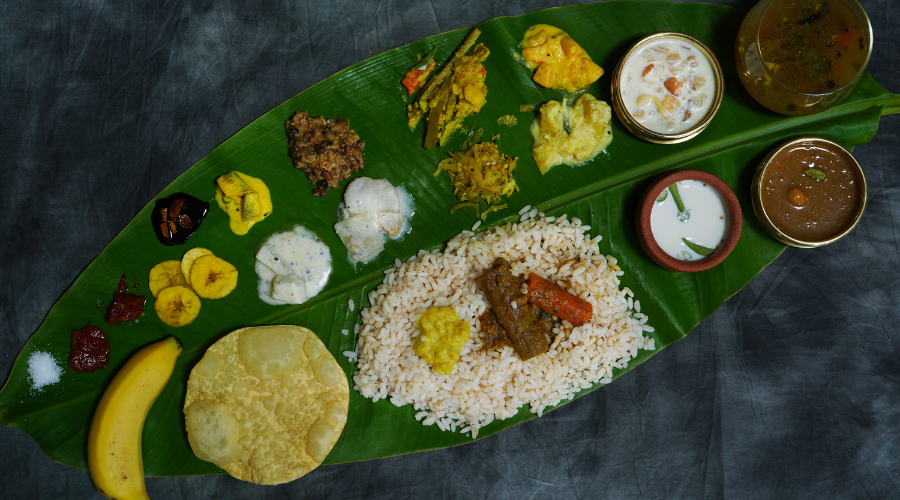As Onam draws near, Kerala readies itself for a festival that is far more than rituals and revelry—it is a season of devotion, joy, cultural pride, and above all, the irresistible charm of its grand vegetarian feast, the famed Sadhya.
Celebrated in the Malayalam month of Chingam, which usually falls between August and September, Onam stretches across 10 festive days. It begins with Atham and culminates with Thiruvonam—the most significant day—marking a crescendo of celebrations that see a coming together of tradition, spirituality, and culinary indulgence. This year’s festivities will begin on August 26 and conclude on September 5.
What Is Onam Sadhya?
At the very core of these festivities lies the Sadhya, a feast that embodies both heritage and hospitality. Traditionally prepared on Thiruvonam, the spread features 26–28 dishes, ranging from fried vegetables and tangy pickles to creamy curries and luscious desserts.
The experience is as humbling as it is grand. More than two dozen dishes, sometimes as many as 64, are prepared using over 60 ingredients. The spread is lovingly served on fresh banana leaves, known locally as Vazhayila. Diners sit cross-legged and savour the meal with their hands.
Staple ingredients like coconut, yam, lentils, and jaggery form the heart of preparations like avial, pulissery, sambhar, and palada—a festival favourite. Red rice anchors the meal, while sharkara varatti, pappadam, erissery, thoran, mezhukkupuratti, kootu curry, rasam, olan, parippu curry, pachadi, payasam, and pickles add richness and variety.
Carefully arranged in a specific order on the banana leaf—from the top left corner moving toward the centre—the Sadhya is as much about presentation and tradition as it is about flavour. Beyond serving a delight to the taste buds, the meal offers a wholesome balance of vitamins, minerals, carbohydrates, and proteins.
Rooted In Myth And Memory
Onam, also known as Thiru-Onam or Thiruvonam, is a rice harvest festival deeply rooted in Kerala’s mythology and history.
The origin of Onam, and Sadhya, are intertwined with the legend of King Mahabali who was a benevolent ruler loved by his people. His reign was so virtuous that it caught the attention of the gods. To test his humility, Lord Vishnu descended in the guise of Vamana, a diminutive Brahmin, and asked Mahabali for three feet of land. With two steps, Vamana covered the earth and the heavens. For the third, the king humbly offered his head. Pleased by this act of devotion, Vishnu granted Mahabali a boon: to return once a year to visit his subjects. Onam celebrates this annual homecoming, with the Sadhya standing as a grand symbol of Kerala’s respect for its past,
The Sadhya is not merely a feast but an experience that is prepared with care, shared with love, and remembered long after the festival ends. Each dish carries with it the essence of tradition, family, and community, turning the meal into a moment of unity.
Five Iconic Dishes Of The Onam Sadhya

The Sadhya is a culinary spectacle, and its charm lies in the wide variety of dishes it brings together. Here are five that hold a special place on the festive banana leaf:
Avial – A quintessential Kerala delicacy, Avial is a thick stew prepared with an assortment of vegetables—traditionally around 13—found in the Western Ghats. Cooked with grated coconut and seasoned generously with coconut oil and curry leaves, the dish is both hearty and fragrant. Only firm, crisp vegetables are chosen, such as elephant foot yam, raw plantain, ash gourd (wax gourd), carrots, beans, brinjal, cucumber, drumstick pods, snake gourd, and broad beans, among others.
Mezhukkupuratti – A simple yet flavourful stir-fry, Mezhukkupuratti highlights Kerala’s love for spiced vegetables. Prepared with chopped onions or shallots and lightly sautéed in aromatic spices, the dish often uses vegetables like unripe plantain, earning it the name Vazhakka Mezhukkupuratti.
Rasam – Known in some regions as Saatramudhu, Rasam is a tangy, spicy soup-like dish, typically served alongside rice. Though it shares space in a meal with Sambhar, Rasam stands apart with its distinct seasoning and lighter, more watery consistency. Tamarind, tomatoes, warming spices, and fresh herbs come together to create its signature punch of flavour.
Kootu Curry – Also called Koottukari or Kootu Kari, this dish is a thick, wholesome curry made by blending vegetables and legumes. Commonly used vegetables include yam, ash gourd, carrots, snake gourd, pumpkin, or plantain, paired with protein-rich legumes such as black chickpeas (kala chana) or Bengal gram (chana dal).
Parippu Payasam – No Sadhya is complete without dessert, and Parippu Payasam (also known as Parippu Pradhaman) is the star of the sweet offerings. This traditional Kerala delicacy combines moong lentils with the richness of coconut milk and the deep sweetness of jaggery, resulting in a creamy, indulgent finale to the grand feast.









